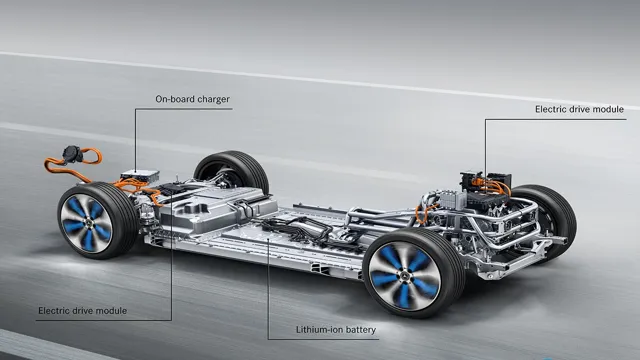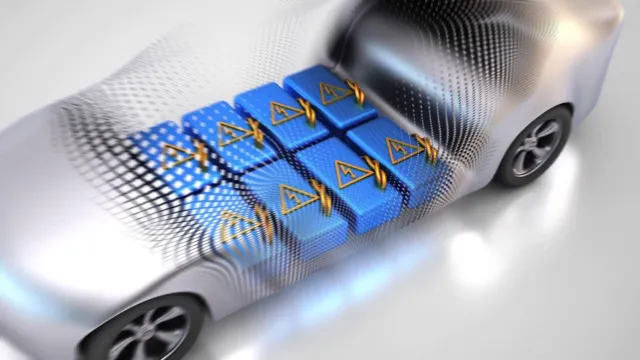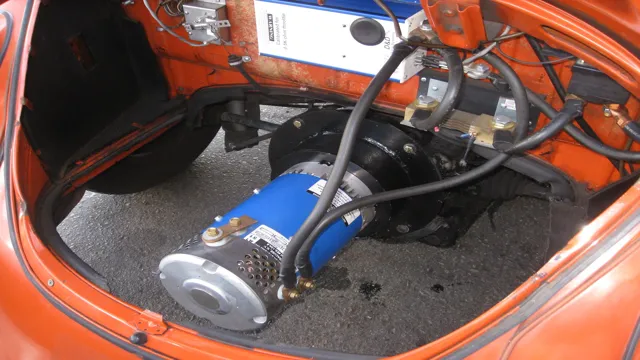Revamping Your Ride: A Complete Guide to Changing Batteries in Electric Cars
Electric cars have become a popular choice for drivers looking to reduce their emissions and lower their carbon footprint. Yet, as with any vehicle, electric cars require maintenance to keep them in top condition. One aspect of electric car maintenance that many drivers have questions about is the battery.
Unlike traditional cars that rely solely on a gasoline engine, electric cars use a battery to power the vehicle. So how do you change the battery in an electric car? Is it something that you can do yourself or do you need to take it to a professional? In this blog post, we will explore the ins and outs of changing the battery in an electric car.
Why Consider Changing Batteries?
If you are looking to buy an electric car, you may have heard of the concept of changing batteries. While electric cars are great for the environment and offer a range of benefits, battery life can be a concern for some drivers. In certain situations, you may find yourself needing to change the battery in your electric car.
This could be because it has become worn out or no longer holds as much charge as it used to. Changing batteries in electric cars can ensure that your vehicle continues to run smoothly and efficiently. By replacing an old battery with a new one, you can extend the life of your electric car and ensure that it continues to serve you well for years to come.
Not only that, but you can also save money on repairs and maintenance in the long run by staying on top of your electric car’s battery life. Overall, considering changing batteries in your electric car is a smart choice if you want to keep your vehicle in top condition.
Longevity and Warranty Issues
When it comes to the longevity and warranty issues of batteries, it’s essential to consider why changing batteries may be necessary. Over time, batteries can lose their ability to hold a charge, making them less efficient and reliable. This is especially true for rechargeable batteries, which can suffer from “memory effect” if they are not completely discharged before being recharged.
This, in turn, can lead to reduced battery life and a need to replace the battery sooner than expected. Additionally, some batteries may be prone to bursting or catching fire, creating a safety hazard that cannot be ignored. By understanding the risks associated with aging batteries and keeping an eye on their performance, you can ensure that your devices continue to function properly and safely.
A regular battery replacement schedule can also help you avoid unexpected downtime and minimize the costs associated with emergency repairs or replacements.

Performance and Range
If you’re thinking about changing batteries in your electric vehicle, the two main factors you’ll want to consider are performance and range. Over time, your battery’s performance can begin to decline, leading to slower acceleration and less efficient energy usage. This can be frustrating for drivers who are used to the instant torque and responsiveness of electric vehicles.
Additionally, if your battery’s range has significantly decreased, you may find yourself regularly needing to recharge your vehicle or having to plan your routes more carefully. By changing your battery, you can restore your vehicle’s performance and range and get back to enjoying the benefits of driving electric.
Factors to Consider When Changing Batteries
When it comes to changing batteries in electric cars, there are a few factors that one should consider. Firstly, it’s important to choose the right type of battery for your vehicle, as different electric cars have different battery requirements. Additionally, it’s important to consider the cost of the battery, as well as the warranty and expected lifespan of the battery.
It’s also important to consider the environmental impact of the battery, as well as the potential for future advancements in battery technology. Finally, when changing the batteries in an electric car, it’s important to work with a qualified professional to ensure that the process is safe and efficient. Overall, changing batteries in electric cars is an important and often necessary task, and with the right considerations, it can be done effectively and efficiently.
Battery Type and Size
Changing the type and size of batteries is a common practice, but it can be a bit tricky, especially if you’re not familiar with the factors to consider. One of the first things to keep in mind is the battery chemistry. Different battery chemistries have unique characteristics that can impact the performance and safety of your device or equipment.
For example, lithium-ion batteries are lightweight and have a high energy density, making them ideal for portable electronic devices. On the other hand, lead-acid batteries are heavy and have a lower energy density, but they are more affordable and can provide high discharge currents, making them suitable for vehicles and backup power systems. Another thing to consider is the physical dimensions of the battery.
Electronic devices and equipment are designed to accommodate specific battery sizes and shapes, so it’s essential to choose a battery that fits snugly in the battery compartment and can deliver the required power output. By considering these factors, you can choose the right battery type and size that meets your specific needs while ensuring optimal performance and safety.
Cost and Budget
When it comes to changing batteries, cost and budget are important factors that must be considered. The price of batteries can vary greatly, depending on the type of battery and the brand. It’s important to consider the affordability of the battery options available before making a purchase.
Cheaper batteries may seem like a better option in the short term, but may not be as cost-effective in the long term due to their shorter lifespan and lower quality. It’s often better to invest in a higher quality battery that may cost more upfront but will save money in the long run. It’s also important to consider the cost of any accessories or tools needed to properly change the battery, such as a wrench or screwdriver.
By carefully considering cost and budget, you can make an informed decision when changing batteries that will save you money and keep your devices running smoothly.
Brand Reputation and Quality
When considering changing the batteries in your device, one of the most important factors to keep in mind is the brand reputation and quality of the battery that you are considering. Choosing a trusted brand with a good reputation can provide peace of mind that your device will continue to function properly and efficiently with the new battery. Additionally, evaluating the quality of the battery can have a significant impact on its lifespan and overall performance.
It is recommended to opt for a high-quality, efficient battery that is specifically designed for your device. Although it may be tempting to opt for a cheaper, generic battery option, doing so can ultimately lead to less reliable and potentially dangerous performance. In short, investing in a reputable and high-quality battery can help ensure the longevity and reliability of your device.
How to Change Batteries in Electric Cars
Changing batteries in electric cars might seem like a daunting task, but it’s actually quite simple. First, you’ll want to make sure the car is turned off and the keys are out of the ignition. Locate the battery compartment, which is usually found under the hood or in the trunk.
Next, use a wrench to loosen the nuts that secure the battery clamps to the posts. Carefully remove the clamps and lift the old battery out of the compartment. Replace it with the new battery, making sure the positive and negative terminals are correctly aligned.
Finally, reattach the clamps and tighten the nuts securely. It’s important to note that electric car batteries are usually heavier than traditional car batteries, so it’s a good idea to have someone help you lift it into place. With proper care and maintenance, your electric car’s battery should last for many years to come.
Step-by-Step Guide
Changing the batteries in electric cars can feel like a daunting task, but it’s actually easier than you might think. Follow these simple steps to swap out the old batteries and get your electric car back on the road. First, make sure your car is turned off and parked in a safe location.
Locate the battery pack, which is usually located under the floor of the car or in the trunk. Next, disconnect the negative cable from the battery, then remove the battery from its compartment. Replace the old batteries with new ones that match the specifications of your car.
Be sure to handle the batteries with care, as they can be heavy and potentially dangerous if mishandled. Once the new batteries are installed, reconnect the negative and positive cables to the battery pack. Double-check to ensure the connections are secure before turning the car back on.
It’s recommended to have a professional mechanic assist with the battery replacement process if you’re unsure or uncomfortable with any of the steps. By switching out the old batteries for new ones, you’ll be able to extend the lifespan of your electric car and ensure it’s running efficiently.
Tools Required
If you’re wondering how to change the battery in your electric car, you’ve come to the right place! Before you start, make sure you have the necessary tools. You’ll need a pair of gloves, safety glasses, and a wrench to help you safely remove the old battery. Once you have everything ready, the next step is to locate the battery.
In most electric cars, the battery is positioned beneath the car’s floor. You’ll need to raise the car using a jack and secure it with jack stands to access the battery. Afterward, disconnect the negative cable from the battery first, then the positive one.
Loosen and remove any bolts holding the battery in place before lifting the old battery out. You can now insert the new battery in place and secure it before reconnecting the cables, starting with the positive cable first. Remember to wear protective gear throughout the process and dispose of the old battery responsibly.
Changing the battery in your electric car might seem daunting, but with the right tools and steps, it’s an easy task that you can accomplish in no time.
Conclusion
In conclusion, changing batteries in electric cars is like swapping out a superhero’s superpowers. Just as superheroes must recharge their abilities to keep saving the day, electric cars also need their batteries refreshed to keep cruising along. It’s not just about swapping out one battery for another, but about ensuring the longevity and performance of the car’s entire electrical system.
So next time you switch out your EV’s battery, remember that you’re giving it a whole new lease on electric life. Now, if only we could make batteries that give electric cars the ability to fly..
.”
FAQs
How often do I need to change the batteries in an electric car?
The lifespan of electric car batteries varies, but typically they can last for several years before needing replacement. It’s important to follow the manufacturer’s recommended maintenance schedule to ensure optimal battery health.
Is it difficult to change the batteries in an electric car?
Battery replacement in electric cars should only be performed by a trained technician. It’s a complex process that requires specialized equipment and knowledge to ensure proper installation and safety.
Can I replace the batteries in my electric car myself?
It’s not recommended for owners to attempt battery replacement themselves. Not only is it unsafe, but it could also void any warranties or insurance coverage on the vehicle.
How much does it cost to replace the batteries in an electric car?
The cost of battery replacement for an electric car varies depending on the make and model, as well as the age of the vehicle. In general, it can range anywhere from a few thousand dollars to over $10,000. It’s important to budget for this potential expense when considering the purchase of an electric car.






